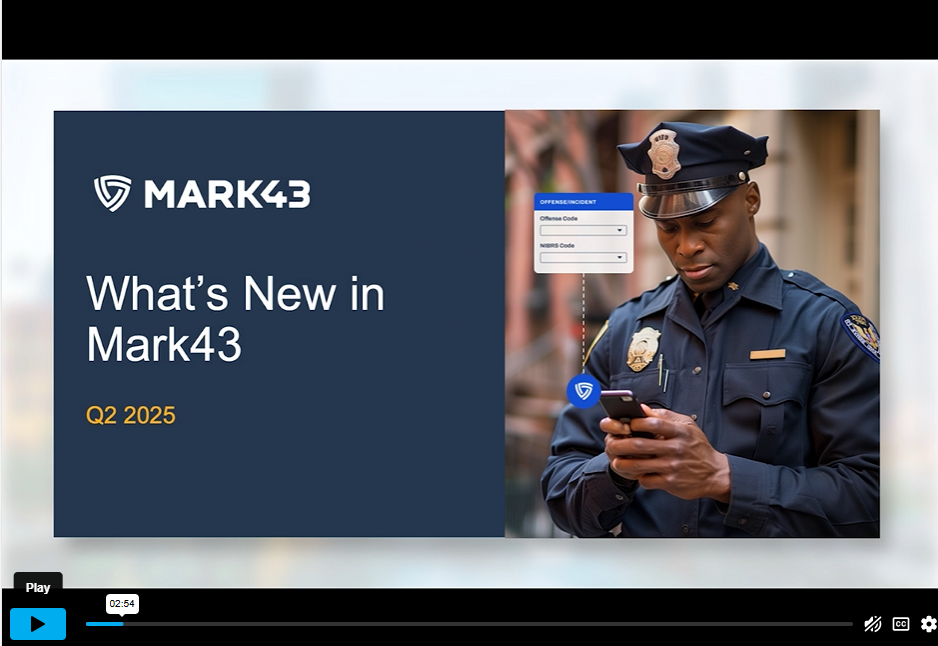
Today’s law enforcement agencies have a greater need for quality data than ever before. This makes the systems that collect data—like a CAD, RMS, or JMS—incredibly significant for any downstream processes, like crime analysis. But data management software is only as reliable as the end-users that input information.
Transitioning to a new software system or workflow isn’t an easy undertaking at any law enforcement agency. It’s difficult, costly, and takes time. So, how can your agency build a successful training program that provides the necessary details to multiple groups of end-users without draining resources?
Let’s take a look at a fairly common training approach that you should employ along with your technology vendor.
Step 1: Conduct a Department Assessment
At the start of any transition, you should work with your vendor to facilitate meetings with a wide-cross section of stakeholders and user groups to learn about what they do and identify what they need to learn.
At Mark43, for example, we shadow call-takers and participate in ride-alongs, to learn the pain points within current systems and gather feedback on what would make jobs easier. These insights inform all training and change management activities and even guide product design improvements.
Step 2: Establish Training Roles
The assessment phase determines how you divide the department into targeted training groups, each with specific content and method requirements. At Mark43, we’ve identified some user roles common to most departments and software tools. These are:
- Department Trainer
- System Administrator
- Function Specific User (such as records, evidence controllers, etc.); and,
- General User
When creating these groups, it’s important to note the level of effort and time required to train each. Analyze the amount of time each user will be using the technology and how complex their tasks will be. If a user is high in both criteria, it might be worth dedicating more training resources to his or her unit or group.
Consider a unique mix of training methods depending on the user group. For example, a system admin might need in-person training and a complete product manual, while a patrol officer might need only a required training video and a quick-start guide for their car. Sample training methods to consider include:
- In-person Training
- Train-the-Trainer
- Side-saddle Training
- Online Videos
- User Guides
- General Support
Step 3: Deploy Training Methods
Key components of the training deployment phase include developing a detailed training schedule that can be shared with learners and leadership. It is critical that your vendor works hard to obtain leadership buy-in and have leadership support the training effort by communicating its importance to the department. Once these actions are complete, it’s time to kickoff training efforts and incorporate learner feedback as training progresses.
It’s helpful to think of the training process as a feedback loop, rather than one-time training. This is especially important for products that involve frequent updates (and thus need frequent training sessions), like cloud-based programs.
A feedback loop model allows vendors and trainers to adapt to users, which can help them adapt more quickly to the systems change they are going through. Hearing and addressing the users’ needs and concerns helps create buy-in from them.
Another way to generate buy-in is to teach users the ‘why’ of a product, and how it will change their day-to-day for the better. Understanding the macro benefits of a new system as well as and the micro benefits to their daily workflows will help people get on board with change.
Step 4: Measure Success
A key step that sometimes gets overlooked is measuring training outcomes. Along with your tech vendor, departments should deploy quick surveys or other measurement tools to track training effectiveness. It’s crucial to identify if any areas of the product require additional training, and if the training method selected was appropriate for future transitions. Whatever the survey approach, you should track early and often.
Likewise, you can use support ticket data to understand which functionality might require retraining. If everyone is struggling with a particular function, it could be time for a refresher, or looking at new training options to help people better understand that aspect of the system.
* * *
Your officers probably learned how to use your department’s new technology, but did they ever learn why? Check out our free webinar Beyond the Manual: Technology Training in the Age of Transparency for insights into how Mark43 can help your department build an effective training program that makes your investment in data management technology worthwhile.







